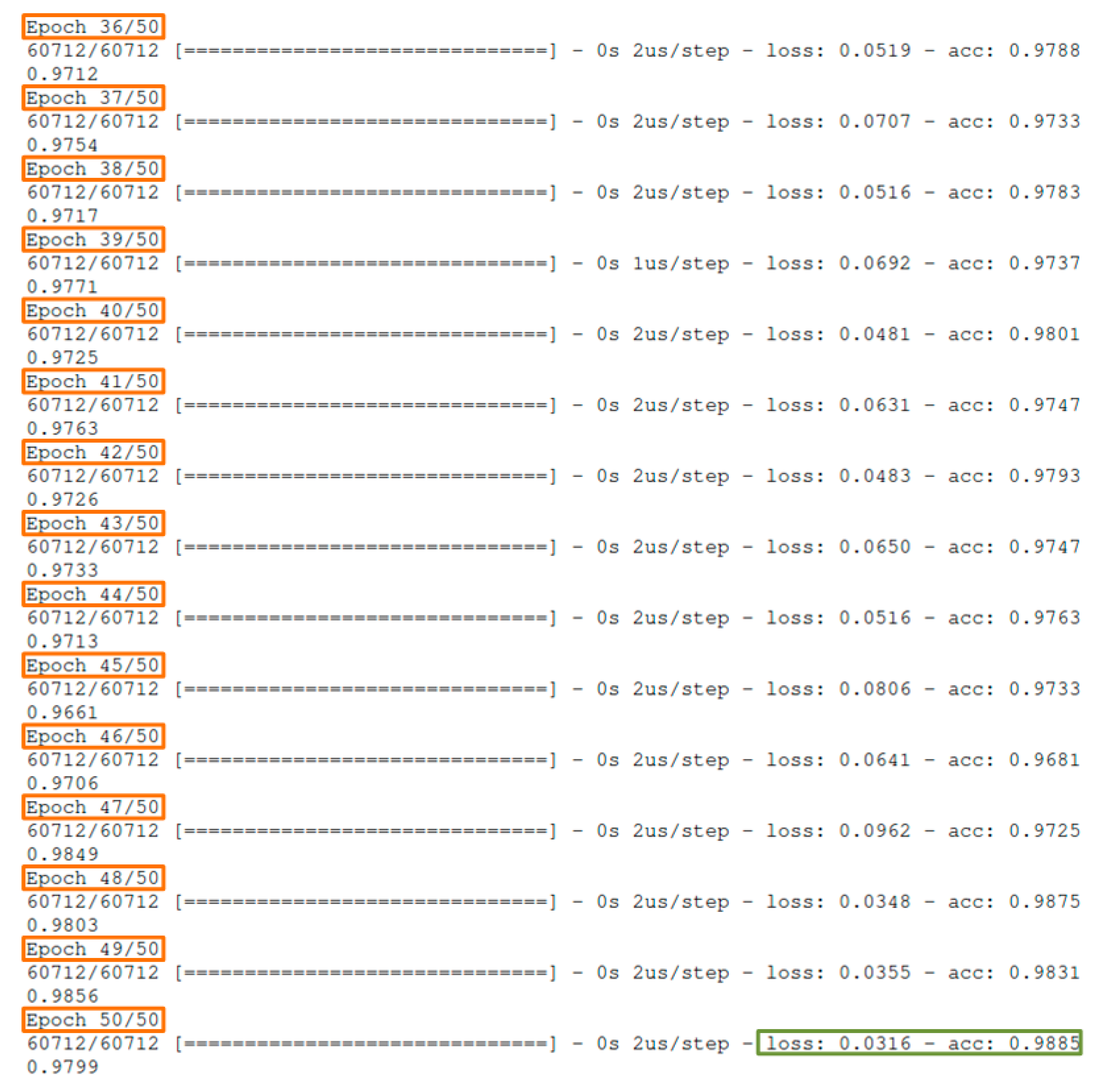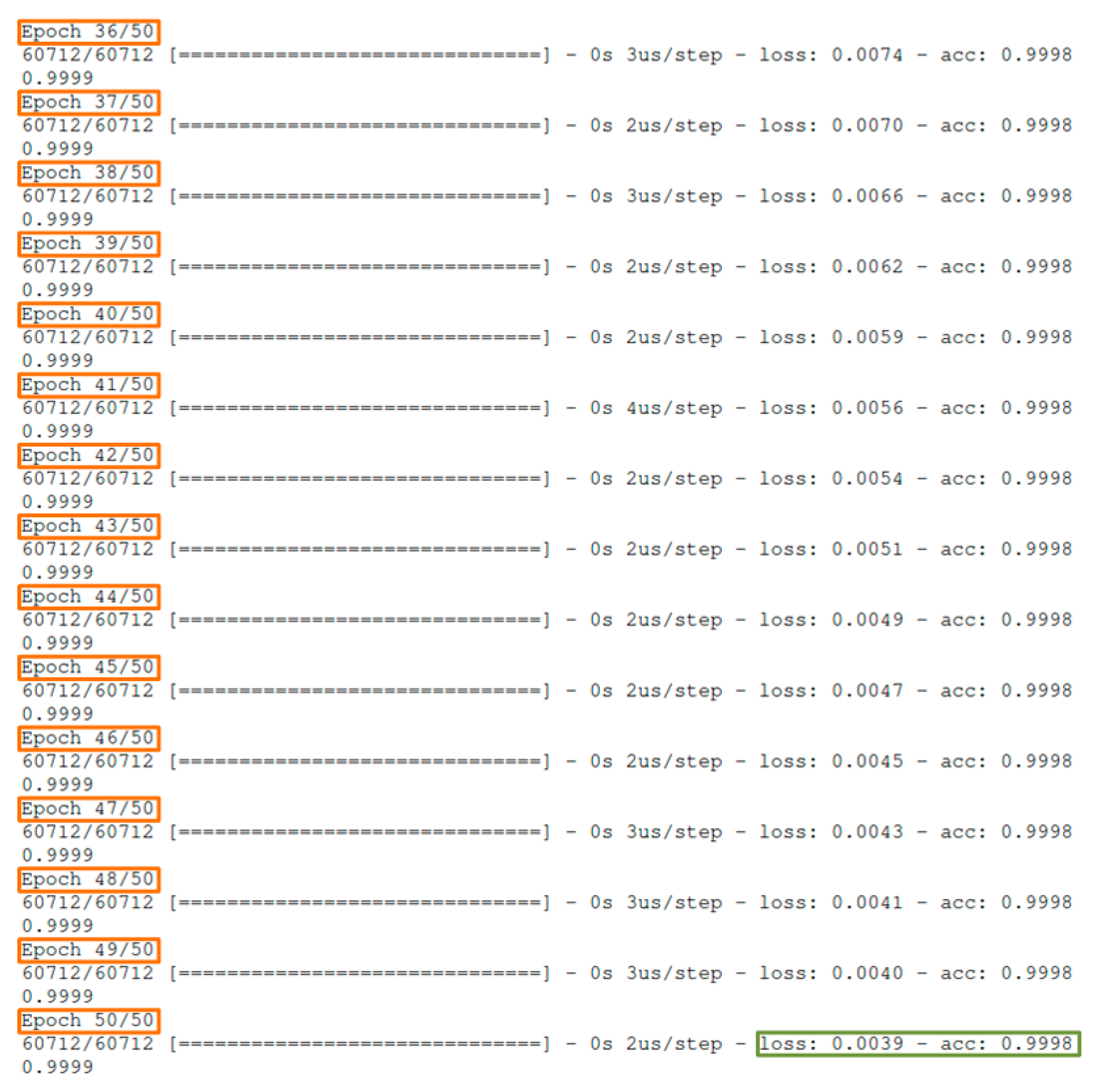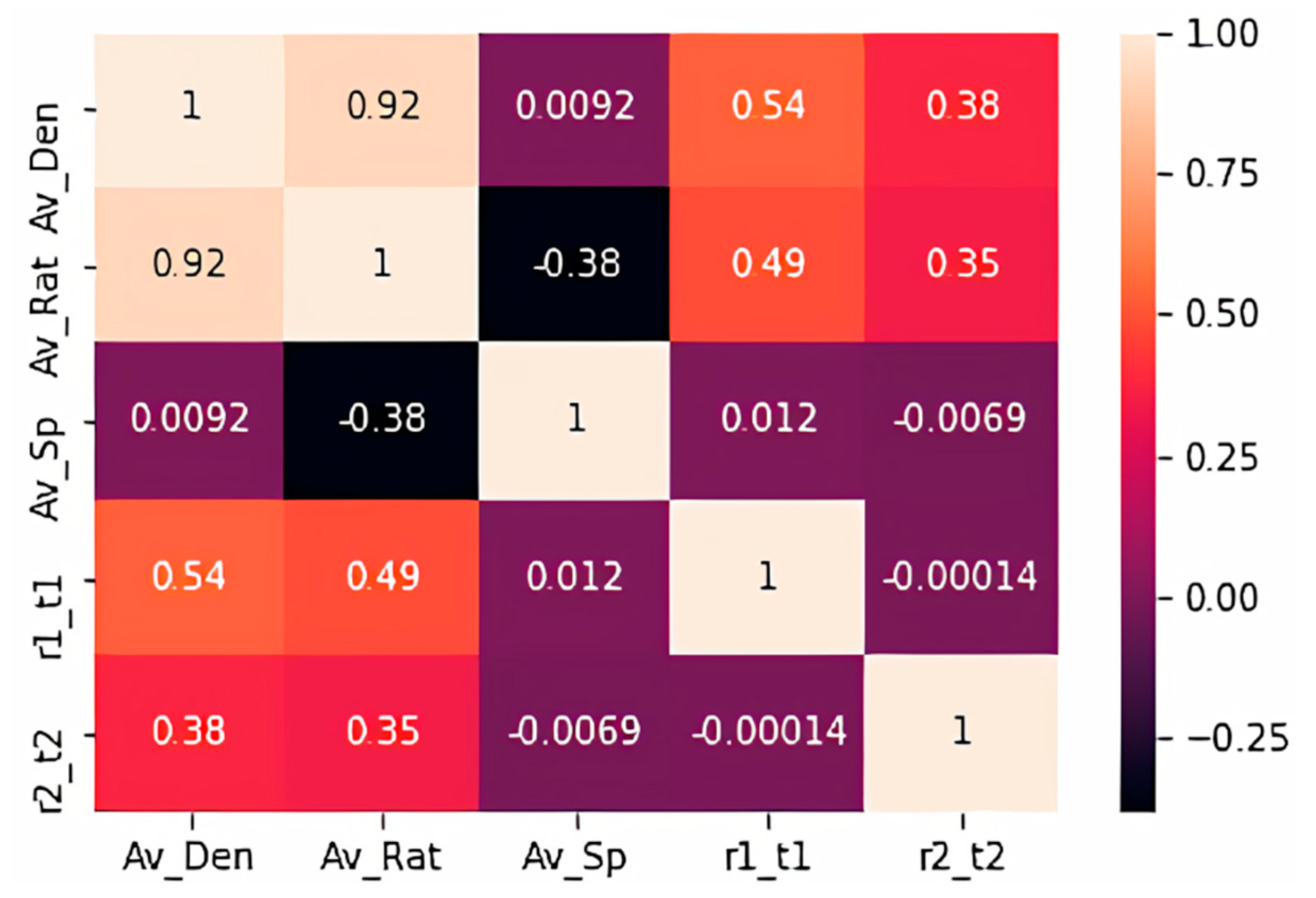An Artificial Intelligence-Based Approach for the Controlled Access Ramp Metering Problem
Abstract
:1. Introduction
2. Ramp Metering: Theory and Related Work
2.1. Theoretical Background
2.2. Related Work and Purpose of the Current Study
3. Highway Modeling and Methodology for the Neural Network Controller
3.1. Highway Modelling
- C, highway section capacity. This value is identical to the set of sectors that the highway has as each sector can have a maximum of one car.
- S, set of cars on the highway in the specific section under examination. The sum is calculated from the total sections with value 1 that exist on the highway.
- ρ the density which is calculated as in Equation (2):ρ = (S/C) × 100%
- One lane and one ramp
- Three lanes and one ramp
- Three lanes and two ramps
- 0–30%, then the red light duration is set to 0 min
- 31–60%, then the red light duration is set to 1 min
- 61–70%, then the red light duration is set to 2 min
- Over 70%, then the red light duration is set to 4 min
3.2. Neural Network for 2-Ramps Metering Control Configuration
- T refers to the discrete time instances.
- Section columns refer to the sections of the highway and contain binary values (0 or 1) which indicate whether there is a car or not in the corresponding section.
- Density contains the value of the density along the entire segment of the highway.
- Average speed is the average vehicle speed for each time point on the highway.
- Ratio (R) is the ratio between density and average speed.
- Output time ramp x columns contain the desired results of the neural network and present the time in minutes for the duration of the red traffic light on each ramp. Each of these columns consists of 4 categorical values, and more specifically the values 0, 1, 2, 4, which refer to the time that each ramp remains closed for the specific period of time.
4. Results and Evaluation
4.1. Results of Different Control Scenarios for Ramp Metering
- The density in all lanes of the highway as shown in Equation (2)
- The average speed as shown in Equation (3)
- The ratio (R) between average speed and density as shown in Equation (4)
- The execution time of the algorithm
- The repetitions performed:where vi is the speed of vehicle i and S the total vehicles on the highway segment examined:R = ρ/V
4.2. Neural Networks Results
4.2.1. Ramp 1-Results
4.2.2. Ramp 2-Results
4.2.3. Overall Results
5. Conclusions and Future Work
- Increase of the number of entrance ramps.
- Application to an entire road network so to utilize even more data and manage more efficiently the traffic flow.
- Engage more complex control conditions for the ramp entrance control.
- Increase the number of hidden layers of the neural network so to increase the accuracy of the results.
Author Contributions
Funding
Institutional Review Board Statement
Informed Consent Statement
Data Availability Statement
Conflicts of Interest
References
- United Nations. Revision of World Urbanization Prospects; United Nations: New York, NY, USA, 2018. [Google Scholar]
- Baskar, L.; Schutter, B.D.; Hellendoorn, J.; Papp, Z. Traffic control and intelligent vehicle highway systems: A survey. IET Intell. Transp. Syst. 2011, 5, 38–52. [Google Scholar] [CrossRef] [Green Version]
- Yan, J.; Bitmead, R.R. Incorporating state estimation into model predictive control and its application to network traffic control. Automatica 2005, 41, 595–604. [Google Scholar] [CrossRef]
- Bielli, M.; Ambrosino, G.; Boero, M.; Mastretta, M. Artificial intelligence techniques for urban traffic control. Transp. Res. Part A Gen. 1991, 25, 319–325. [Google Scholar] [CrossRef]
- Papageorgiou, M.; Hadj-Salem, H.; Middelham, F. ALINEA Local Ramp Metering: Summary of Field Results. Transp. Res. Rec. 1997, 1603, 90–98. [Google Scholar] [CrossRef]
- Papageorgiou, M.; Kotsialos, A. Freeway ramp metering: An overview. IEEE Trans. Intell. Transp. Syst. 2002, 3, 271–281. [Google Scholar] [CrossRef]
- Smaragdis, E.; Papageorgiou, M. Series of New Local Ramp Metering Strategies. Transp. Res. Rec. 2003, 1856, 74–86. [Google Scholar] [CrossRef]
- Roberts, A.; Jacobsen, K.; Thompson, L.; Colyar, N.; Mizuta, J. Ramp Metering: A Proven, Cost-Effective Operational Strategy: A Primer; Federal Highway Administration: Washington, DC, USA, 2014.
- Hall, F.; Agyemang-Duah, K. Freeway Capacity Drop and the Definition of Capacity; Transportation Research Board: Washington, DC, USA, 1991. [Google Scholar]
- Masher, D.P.; Ross, D.; Wong, P.J.; Tuan, P.; Zeidler, H.M.; Petracek, S. Guidelines for Design and Operation of Ramp Control Systems; Transportation Research Board: Washington, DC, USA, 1975. [Google Scholar]
- Chu, L.; Liu, H.X.; Recker, W.; Zhang, H.M. Performance Evaluation of Adaptive Ramp-Metering Algorithms Using Microscopic Traffic Simulation Model. J. Transp. Eng. 2004, 130, 330–338. [Google Scholar] [CrossRef] [Green Version]
- Ghanbartehrani, S.; Sanandaji, A.; Mokhtari, Z.; Tajik, K. A Novel Ramp Metering Approach Based on Machine Learning and Historical Data. Mach. Learn. Knowl. Extr. 2020, 2, 21. [Google Scholar] [CrossRef]
- Zhanfeng, J.; Chao, C.; Coifman, B.; Varaiya, P. The PeMS algorithms for accurate, real-time estimates of g-factors and speeds from single-loop detectors. In Proceedings of the ITSC 2001 IEEE Intelligent Transportation Systems, Oakland, CA, USA, 25–29 August 2001; pp. 536–541. [Google Scholar]
- Hadj-Salem, H.; Blosseville, J.M.; Papageorgiou, M. ALINEA: A local feedback control law for on-ramp metering; A real-life study. In Proceedings of the Third International Conference on Road Traffic Control, 1990, London, UK, 22–24 March 1994; pp. 194–198. [Google Scholar]
- Smaragdis, E.; Papageorgiou, M.; Kosmatopoulos, E. A flow-maximizing adaptive local ramp metering strategy. Transp. Res. Part B Methodol. 2004, 38, 251–270. [Google Scholar] [CrossRef]
- Jiang, R.; Chung, E.; Lee, J.B. Local On-ramp Queue Management Strategy with Mainline Speed Recovery. Procedia Soc. Behav. Sci. 2012, 43, 201–209. [Google Scholar] [CrossRef] [Green Version]
- Chi, R.; Hou, Z.-S.; Jin, S.; Wang, D.; Hao, J. A data-driven iterative feedback tuning approach of ALINEA for freeway traffic ramp metering with PARAMICS simulations. IEEE Trans. Ind. Inform. 2013, 9, 2310–2317. [Google Scholar] [CrossRef]
- Wang, Y.; Kosmatopoulos, E.B.; Papageorgiou, M.; Papamichail, I. Local Ramp Metering in the Presence of a Distant Downstream Bottleneck: Theoretical Analysis and Simulation Study. IEEE Trans. Intell. Transp. Syst. 2014, 15, 2024–2039. [Google Scholar] [CrossRef]
- Frejo, J.R.D.; Schutter, B.D. Feed-Forward ALINEA: A Ramp Metering Control Algorithm for Nearby and Distant Bottlenecks. IEEE Trans. Intell. Transp. Syst. 2019, 20, 2448–2458. [Google Scholar] [CrossRef]
- Liu, Z.; Wu, Y.; Cao, S.; Zhu, L.; Shen, G. A Ramp Metering Method Based on Congestion Status in the Urban Freeway. IEEE Access 2020, 8, 76823–76831. [Google Scholar] [CrossRef]
- Papageorgiou, M.; Blosseville, J.-M.; Haj-Salem, H. Modelling and real-time control of traffic flow on the southern part of Boulevard Peripherique in Paris: Part II: Coordinated on-ramp metering. Transp. Res. Part A Gen. 1990, 24, 361–370. [Google Scholar] [CrossRef]
- Paesani, G.; Kerr, J.; Perovich, P.; Khosravi, F. System wide adaptive ramp metering (SWARM). In Proceedings of the Merging the Transportation and Communications Revolutions, Abstracts for ITS America Seventh Annual Meeting and Exposition, Washington, DC, USA, 2–5 June 1997. [Google Scholar]
- Taylor, C.; Meldrum, D.; Jacobson, L. Fuzzy ramp metering: Design overview and simulation results. Transp. Res. Rec. 1998, 10–18. [Google Scholar] [CrossRef]
- Zhang, H.; Ritchie, S.G.; Lo, Z. A Local Neural Network Controller for Freeway Ramp Metering. IFAC Proc. Vol. 1994, 27, 655–658. [Google Scholar] [CrossRef]
- Zhang, H.M.; Ritchie, S.G. Freeway ramp metering using artificial neural networks. Transp. Res. Part C Emerg. Technol. 1997, 5, 273–286. [Google Scholar] [CrossRef]
- Papageorgiou, M.; Ben-Akiva, M.; Bottom, J.; Bovy, P.; Hoogendoorn, S.; Hounsell, N.; Kotsialos, A.; Mcdonald, M. ITS and traffic management. Handb. Oper. Res. Manag. Sci. 2007, 14, 715–774. [Google Scholar]
- Taale, H.; Slager, J.; Rosloot, J. The assessment of ramp metering based on fuzzy logic. In Proceedings of the 3rd ITS World Congress, Orlando, FL, USA, 14–18 October 1996. [Google Scholar]
- Taylor, C.E.; Meldrum, D.R. Evaluation of a Fuzzy Logic Ramp Metering Algorithm: A Comparative Study among Three Ramp Metering Algorithms Used in the Greater Seattle Area; Washington State Department of Transportation: Olympia, WA, USA, 2000.
- Ghods, A.H.; Kian, A.R.; Tabibi, M. Adaptive freeway ramp metering and variable speed limit control: A genetic-fuzzy approach. IEEE Intell. Transp. Syst. Mag. 2009, 1, 27–36. [Google Scholar] [CrossRef]
- Yu, X.; Xu, W.; Alam, F.; Potgieter, J.; Fang, C. Genetic fuzzy logic approach to local ramp metering control using microscopic traffic simulation. In Proceedings of the 19th International Conference on Mechatronics and Machine Vision in Practice (M2VIP), Auckland, New Zealand, 28–30 November 2012; pp. 290–297. [Google Scholar]
- Xu, J.; Zhao, X.; Srinivasan, D. On optimal freeway local ramp metering using fuzzy logic control with particle swarm optimisation. IET Intell. Transp. Syst. 2013, 7, 95–104. [Google Scholar] [CrossRef]
- Yu, X.F.; Alam, F.; Xu, P. Genetic-fuzzy logic ramp metering control for ramp metering of motorway. Int. J. Comput. Appl. Technol. 2014, 50. [Google Scholar] [CrossRef]
- Wei, C.-H. Analysis of artificial neural network models for freeway ramp metering control. Artif. Intell. Eng. 2001, 15, 241–252. [Google Scholar] [CrossRef]
- Tafti, M. The Development of a Ramp Metering Strategy Based on Artificial Neural Networks. In Applications and Innovations in Intelligent Systems IX; Spinger: London, UK, 2002; pp. 199–212. ISBN 978-1-85233-530-4. [Google Scholar]
- Feng, C.; Yuanhua, J.; Jian, L.; Huixin, Y.; Zhonghai, N. Design of Fuzzy Neural Network Control Method for Ramp Metering. In Proceedings of the 2011 Third International Conference on Measuring Technology and Mechatronics Automation, Shangshai, China, 6–7 January 2011; Volume 1, pp. 966–969. [Google Scholar]
- Chen, F.; Jia, Y.; Niu, Z.; Yi, H.; Song, H. Ramp Metering Research of Junction Based on Fuzzy Neural Network Model. J. Transp. Syst. Eng. Inf. Technol. 2011, 11, 108–113. [Google Scholar] [CrossRef]
- Chen, J.; Lin, W.; Yang, Z.; Li, J.; Cheng, P. Adaptive Ramp Metering Control for Urban Freeway Using Large-Scale Data. IEEE Trans. Veh. Technol. 2019, 68, 9507–9518. [Google Scholar] [CrossRef]
- Jacob, C.; Abdulhai, B. Automated Adaptive Traffic Corridor Control Using Reinforcement Learning: Approach and Case Studies. Transp. Res. Rec. 2006, 1959, 1–8. [Google Scholar] [CrossRef]
- Wang, X.-J.; Xi, X.-M.; Gao, G.-F. Reinforcement Learning Ramp Metering without Complete Information. J. Control Sci. Eng. 2012, 2012, 208456. [Google Scholar] [CrossRef] [Green Version]
- Rezaee, K.; Abdulhai, B.; Abdelgawad, H. Application of reinforcement learning with continuous state space to ramp metering in real-world conditions. In Proceedings of the 2012 15th International IEEE Conference on Intelligent Transportation Systems, Anchorage, AK, USA, 16–19 September 2012; pp. 1590–1595. [Google Scholar]
- Li, Z.; Liu, P.; Xu, C.; Duan, H.; Wang, W. Reinforcement Learning-Based Variable Speed Limit Control Strategy to Reduce Traffic Congestion at Freeway Recurrent Bottlenecks. IEEE Trans. Intell. Transp. Syst. 2017, 18, 3204–3217. [Google Scholar] [CrossRef]
- Yang, H.; Rakha, H.A. Reinforcement Learning Ramp Metering Control for Weaving Sections in a Connected Vehicle Environment. In Proceedings of the Transportation Research Board 96th Annual Meeting, Washington DC, USA, 8–12 January 2017. [Google Scholar]
- Lu Chao; Huang Jie; Deng Lianbo; Gong Jianwei Coordinated Ramp Metering with Equity Consideration Using Reinforcement Learning. J. Transp. Eng. Part A Syst. 2017, 143, 04017028. [CrossRef]
- Zhou, Y.; Ozbay, K.; Kachroo, P.; Zuo, F. Ramp Metering for a Distant Downstream Bottleneck Using Reinforcement Learning with Value Function Approximation. J. Adv. Transp. 2020, 2020, 8813467. [Google Scholar] [CrossRef]
- Chai, G.; Cao, J.; Xu, S. An optimized on-ramp metering method for urban expressway based on reinforcement learning. J. Intell. Fuzzy Syst. 2020, 38, 2703–2715. [Google Scholar] [CrossRef]
- Belletti, F.; Haziza, D.; Gomes, G.; Bayen, A.M. Expert Level control of Ramp Metering based on Multi-task Deep Reinforcement Learning. IEEE Trans. Intell. Transp. Syst. 2017, 19, 1198–1207. [Google Scholar] [CrossRef]
- Yang, M.; Li, Z.; Ke, Z.; Li, M. A Deep Reinforcement Learning-based Ramp Metering Control Framework for Improving Traffic Operation at Freeway Weaving Sections. In Proceedings of the Transportation Research Board 98th Annual Meeting, Washington DC, USA, 13–17 January 2019. [Google Scholar]
- Deng, F.; Jin, J.; Shen, Y.; Du, Y. Advanced Self-Improving Ramp Metering Algorithm based on Multi-Agent Deep Reinforcement Learning. In Proceedings of the 2019 IEEE Intelligent Transportation Systems Conference (ITSC), Auckland, New Zealand, 27–30 October 2019; pp. 3804–3809. [Google Scholar]
- Zhao, L.; Li, Z.; Ke, Z.; Li, M. Fuzzy self-adaptive proportional–integral–derivative control strategy for ramp metering at distance downstream bottlenecks. IET Intell. Transp. Syst. 2020, 14, 250–256. [Google Scholar] [CrossRef]















| Technique | Local or Systemic Nature | Future Data Predictions | Computational Complexity |
|---|---|---|---|
| Optimal control and model predictive control | Systemic | Yes | High |
| Artificial Intelligence | Local and systemic | Yes | Medium or high |
| Static feedback control | Local | No | Low |
| Method | Studies |
|---|---|
| Demand-Capacity | [8,10,26] |
| Occupancy | [8,10,13] |
| ALINEA based | [5,7,14,15,16,17,18,19,20] |
| Fuzzy logic | [23,27,28,29,30,31,32] |
| Neural Networks | [24,25,33,34,35,36,37] |
| Reinforcement Learning | [38,39,40,41,42,43,44,45] |
| Deep Reinforcement Learning | [46,47,48,49] |
| Discrete Time Instance (T) | Section 1 | … | Section n | Density | Average Speed V | Ratio (R) | Output Time Ramp 1 | Output Time Ramp 2 |
|---|---|---|---|---|---|---|---|---|
| T = 1 | 0 | … | 1 | 52 | 100 | 0.42 | 1 | 2 |
| T = 2 | 0 | … | 0 | 48 | 105 | 0.47 | 1 | 2 |
| … | … | … | ||||||
| T = n | 1 | … | 1 | 60 | 90 | 0.55 | 4 | 1 |
| Scenario | Density (%) | Average Speed (km/h) | Ratio-R | Execution Time (s) | Repetitions |
|---|---|---|---|---|---|
| 1 lane & 1 ramp | 63.45 | 76.71 | 0.8 | 4.08 | 4383 |
| 3 lanes & 1 ramp | 55.37 | 78.85 | 0.76 | 12.59 | 4467 |
| 3 lanes & 2 ramps | 61.70 | 77.86 | 0.79 | 300 | 108,016 |
| Ramp | Accuracy Train Set | Loss Train Set | Accuracy Test Set | Loss Test Set |
|---|---|---|---|---|
| Ramp 1 | 98.15% | 3.16% | 98.20% | 3.99% |
| Ramp 2 | 99.98% | 0.39% | 99.99% | 0.36% |
Publisher’s Note: MDPI stays neutral with regard to jurisdictional claims in published maps and institutional affiliations. |
© 2021 by the authors. Licensee MDPI, Basel, Switzerland. This article is an open access article distributed under the terms and conditions of the Creative Commons Attribution (CC BY) license (http://creativecommons.org/licenses/by/4.0/).
Share and Cite
Alexakis, T.; Peppes, N.; Adamopoulou, E.; Demestichas, K. An Artificial Intelligence-Based Approach for the Controlled Access Ramp Metering Problem. Vehicles 2021, 3, 63-83. https://0-doi-org.brum.beds.ac.uk/10.3390/vehicles3010005
Alexakis T, Peppes N, Adamopoulou E, Demestichas K. An Artificial Intelligence-Based Approach for the Controlled Access Ramp Metering Problem. Vehicles. 2021; 3(1):63-83. https://0-doi-org.brum.beds.ac.uk/10.3390/vehicles3010005
Chicago/Turabian StyleAlexakis, Theodoros, Nikolaos Peppes, Evgenia Adamopoulou, and Konstantinos Demestichas. 2021. "An Artificial Intelligence-Based Approach for the Controlled Access Ramp Metering Problem" Vehicles 3, no. 1: 63-83. https://0-doi-org.brum.beds.ac.uk/10.3390/vehicles3010005






